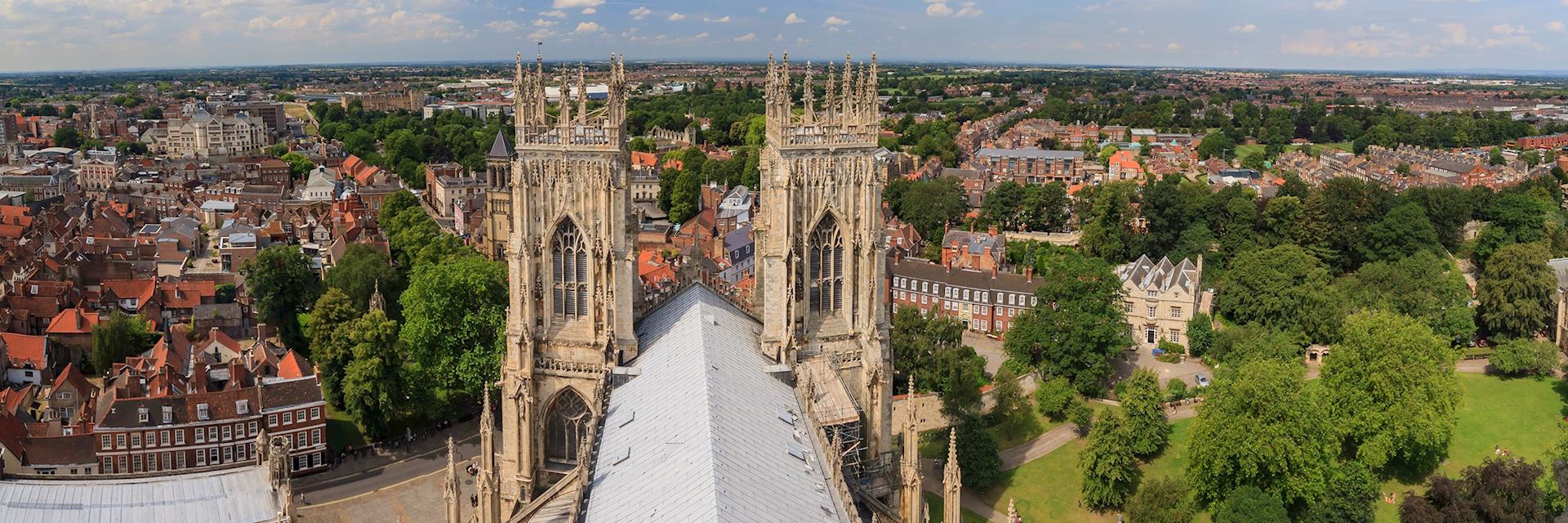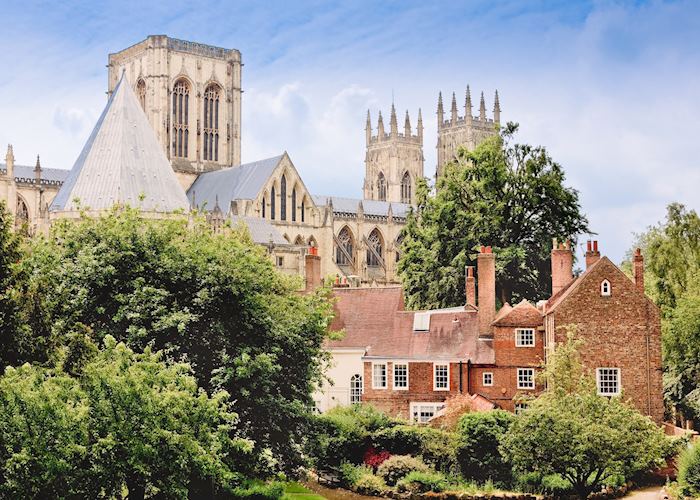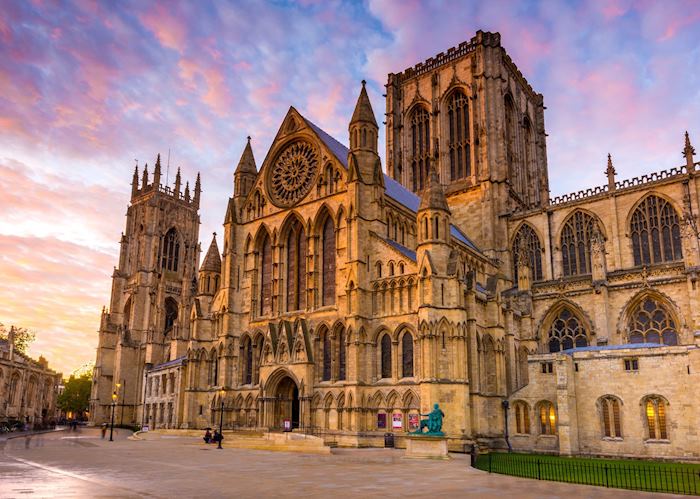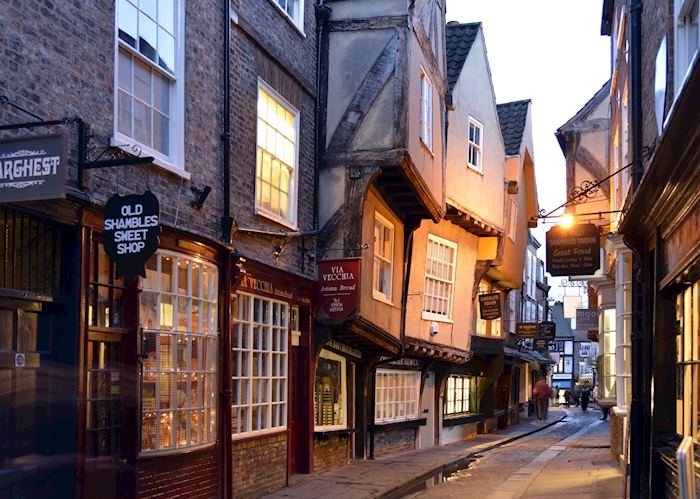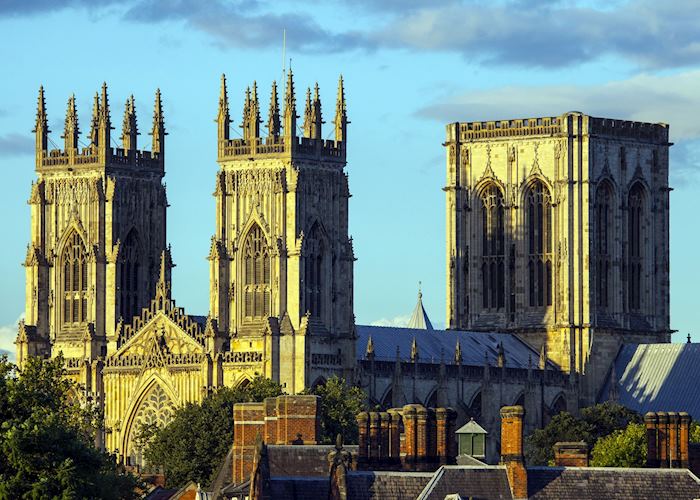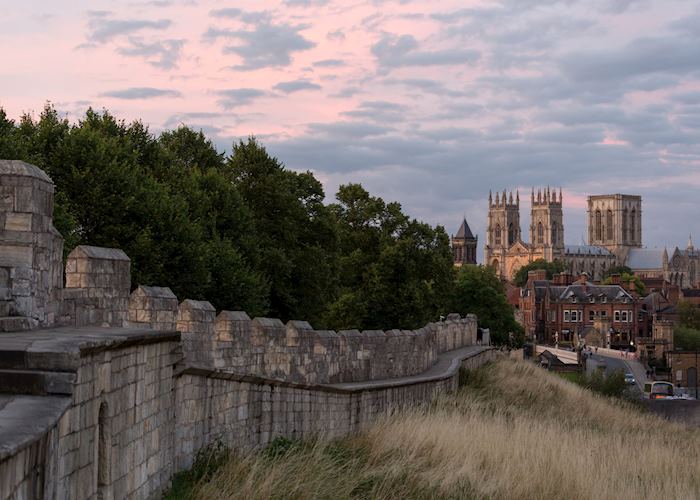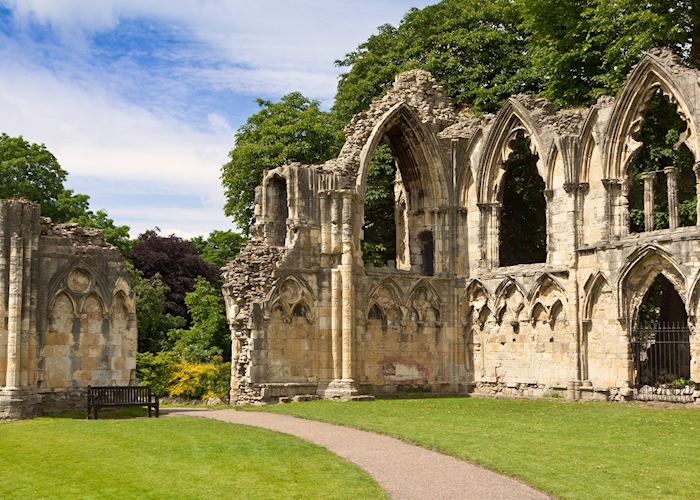Jump to:
A city with a history extending back to the Roman occupation of Britain and a glorious medley of medieval, Georgian and Victorian architecture, York is extraordinarily well preserved. Next to London, it was England's most important city until the Industrial Revolution and is home to York Minster, one of the most magnificent Gothic cathedrals in Europe.
Around the minster lies a warren of cobbled streets flanked by topsy-turvy buildings and encircled by medieval city walls. Along with this, York has a strong Viking heritage and several compelling museums as well as many interesting shops, galleries, gardens and tea rooms.
Ireland specialist AndeaFrom Roman and medieval walls to alleyways crammed with shops, pubs, and restaurants, York is very walkable. Even on a casual saunter through the city streets, you stumble across ruins dating back hundreds of years.
Things to see and do in York
York Minster
 One of the world's most beautiful examples of Gothic architecture, York Minster was begun in 1220 and took over 250 years to complete. The unexpectedly tall and wide nave is lit through the enormous East Window, the world's largest piece of medieval stained glass, and the Great West Window with its intricate heart-shaped tracery.
One of the world's most beautiful examples of Gothic architecture, York Minster was begun in 1220 and took over 250 years to complete. The unexpectedly tall and wide nave is lit through the enormous East Window, the world's largest piece of medieval stained glass, and the Great West Window with its intricate heart-shaped tracery.
Most famous, however, is the Rose Window in the transept, which commemorates the marriage of Henry VII and Elizabeth of York in 1486 — a union which brought an end to the bitter War of the Roses. You can also see the chapter house, crypt and foundations, where you can spot fragments of earlier buildings in the stonework. There’s a small museum in the undercroft and sweeping views of the city from the top of the central tower.
Roman, Viking and medieval history
Archeological evidence suggests York was first settled between 8000 and 7000 BC, but it was the Romans who left a more permanent mark on the landscape. The remains of one of their forts, which was begun in 71 AD, can still be seen in the city walls and in the undercroft of York Minster.
The Vikings took control in 875 and Jorvik, as they called the city, became a thriving trade and economic hub. Today you can see a vivid reconstruction of a Viking settlement at the Jorvik Viking Centre, which brings this period to life through brilliantly devised interactive exhibits.
York became the seat of the archbishop in medieval times and continued to prosper, with many of the buildings from this era still standing on the city's meandering streets.
York's medieval streets
 York's medieval streets (known confusingly as gates) are the arteries of the city. Stonegate, originally a Roman road, is flanked by lopsided Tudor buildings housing cafés, shops and pubs. The alleyway by Ye Olde Starre, York's oldest inn, leads to Barley Hall, a reconstructed medieval townhouse.
York's medieval streets (known confusingly as gates) are the arteries of the city. Stonegate, originally a Roman road, is flanked by lopsided Tudor buildings housing cafés, shops and pubs. The alleyway by Ye Olde Starre, York's oldest inn, leads to Barley Hall, a reconstructed medieval townhouse.
York's most photographed road is the Shambles, a sliver of a street set between leaning and buckled timber-framed buildings that date back centuries. Throughout this part of the city are a network of snickelways — tiny, narrow lanes between buildings that lead to the old marketplaces. They often offer unique views of the city and its buildings.
A walled city
In the 14th century, York's wooden palisade was replaced by a stone wall winding 4 km (2.5 miles) around the medieval city and castle. In places, particularly along the northern sections, the wall follows the line of the old Roman ramparts, and some of the four main gates, known locally as bars, were built on Roman foundations.
Monk Bar, the largest and most ornate gate, has been used as a home and a jail over the years. Today, it hosts a small, quirky museum to Richard III that seeks to overturn his somewhat nefarious reputation. Micklegate Bar, a fortified tower, was sometimes used to display the heads of executed traitors and its intriguing story is told inside.
A stroll along the walls, or even part of them, offers an uninterrupted view over the city and in places, excellent views of the cathedral.
York’s architecture
York has a wealth of architecture that spans several centuries. York Minster is the star attraction, but around it you'll find a warren of medieval streets. There are also much grander buildings such as the Merchant Adventurers' Hall, a 14th-century timber-framed guildhall. By the cathedral is the stately 16th-century Treasurer's House, once home to the Archbishop of York, and now filled with antique furniture, art and textiles.
In the 18th century, York became the social hub of the north of England, and many fine buildings were erected as the wealthy moved into town. A good example is the Georgian Fairfax House, which gives a vivid glimpse of how the gentry lived at the time.
Although the Industrial Revolution largely passed York by, the arrival of the railway had a significant impact on the city. Many new buildings sprung up, including libraries and colleges, as well as the grandiose Royal Station Hotel (now the Principal York).
who's been there
-
617-223-4521617-223-4752
- Make an inquiry
Suggested itinerary featuring York
This sample itinerary will give you an idea of what is possible when you travel in York, and showcases routes we know work particularly well. Treat this as inspiration, because your trip will be created uniquely by one of our specialists.
Places near York
- Liverpool 87 miles away
- The Lake District 89 miles away
- Stratford-upon-Avon 125 miles away
- Cambridge 132 miles away
- The Cotswolds 143 miles away
- Oxford 154 miles away
- Edinburgh 162 miles away
- London 175 miles away
- St Andrews 178 miles away
- Glasgow 182 miles away
- Bath 187 miles away
- Loch Lomond 200 miles away
- Canterbury 207 miles away
- The Highlands 214 miles away
- Brighton 221 miles away
- The White Cliffs of Dover 221 miles away
- Rye 222 miles away
- Loch Awe 231 miles away
- The Cairngorms 235 miles away
- Isle of Jura 237 miles away
- Isle of Islay 241 miles away
- Oban 243 miles away
- Glencoe 246 miles away
- Fort William 253 miles away
- Speyside 257 miles away
- Loch Ness 268 miles away
- Inverness 273 miles away
Photos of York
Accommodation choices for York
We’ve selected a range of accommodation options for when you visit York. Our choices usually come recommended for their character, facilities and service or location. Our specialists always aim to suggest properties that match your preferences.
-
![Best Western Plus Dean Court, York]()
-
![The Grange Hotel, York]()
No 1
York -
![The Principal York, York]()
The Principal York
York -
![Middlethorpe Hall & Spa, York]()
-
![The Grand Hotel & Spa, York]()
Ideas for experiencing York
Our specialists seek out authentic ways to get to know the places that could feature in your trip. These activities reflect some of the experiences they've most enjoyed while visiting York, and which use the best local guides.
-
Castle Howard and Rievaulx Abbey ![Castle Howard]()
Castle Howard and Rievaulx Abbey
Castle Howard and Rievaulx Abbey
Take a private guided driving tour of the windswept North York Moors. Visit the house and gardens of the stately Castle Howard, continue on to the pretty market town of Helmsley, and end at the haunting ruins of nearby Rievaulx Abbey.
View details -
Ancient York walking tour ![York Minster]()
Ancient York walking tour
Ancient York walking tour
Discover the pivotal role that York has played in English history over the past 2,000 years. Your private guide will lead a walking tour to visit the city’s gates, walls and medieval churches, as well as the tiny, crooked alleys called snickelways.
View details
